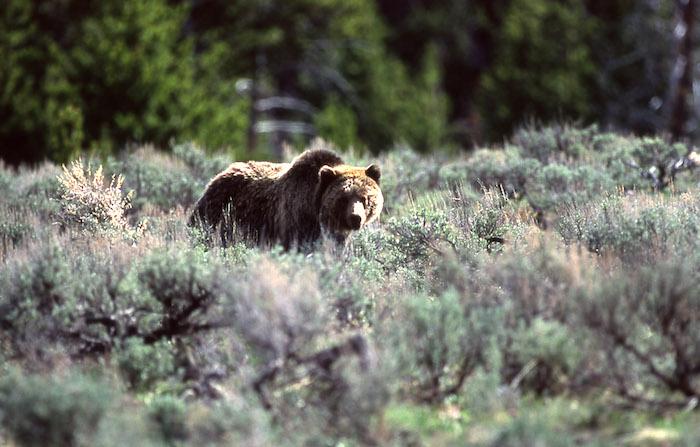
Yellowstone National Park Superintendent was the only voice of opposition to a plan for managing grizzly bears in the Greater Yellowstone Ecosystem if they are removed from the Endangered Species List/NPS
Just one vote against a conservation strategy intended to see that grizzly bears in the Greater Yellowstone Ecosystem thrive after they lose Endangered Species Act protections was voiced, and that came from the superintendent of Yellowstone National Park, the core of the ecosystem and heart of grizzly bear recovery.
Whether Sue Masica, the regional director for the National Park Service's sprawling Intermountain Region who must sign off on the strategy, will share Dan Wenk's concerns remains to be seen. She was traveling Friday and not available for comment. The two are expected to talk about the matter in the coming weeks.
But Superintendent Wenk in the past has said any strategy that allows the hunting of grizzly bears in the John D. Rockefeller, Jr. Memorial Parkway that lies between Yellowstone and Grand Teton National Park would not gain Park Service support. So it shouldn't be a great surprise that he voted against the conservaton strategy that was approved by the Yellowstone Ecosystem Subcommittee of the Interagency Grizzly Bear Committee last Wednesday.
On Thursday, the Yellowstone superintendent also expressed concerns about the "ambiguity" of the conservation strategy's intent to continue to base grizzly bear populations on the so-called Chao2 estimator, which factors in numbers of grizzly sows not observed by researchers working on estimates. While the conservation strategy said the Chao2 methodology would be used for the "foreseeable future," Superintendent Wenk wanted greater assurance that Chao2 would remain in the plan.
Some see the Chao2 method as being too conservative, and that the grizzly bear population could be substantially higher than the nearly 700 bears thought to be in the ecosystem. If the population is, for example, actually 1,100 bears, then quotas for hunters could be higher. As a result, there could be pressure down the line to move to a more liberal estimator that could allow Wyoming, Montana, and Idaho to sell more bear hunting licenses.
Interestingly, while Superintendent Wenk voted against the conservation strategy, Grand Teton National Park's representative at the meeting on Wednesday, Sue Consolo-Murphy, the park's chief of science and resource management, supported it.
“There’s a lot of the conservation strategy that I think does a great deal to address how the agencies have committed in the long-term to maintain a stable population of bears, and most importantly to maintain the habitat," she said Friday.
"Grand Teton, at this park, we’re comfortable with the conservation strategy and we think it does what the conservation strategy was intended to do," added park spokeswoman Denise German, who sat in on the phone call. "It was all the agencies coming together and working collaboratively.”
What remains to be seen is which park Regional Director Masica sides with.
What isn't in the conservation strategy is not only whether hunting will be allowed within the Rockefeller Parkway, but also whether grizzly bears could be hunted on private and state inholdings that lie within Grand Teton's boundaries.
“We really haven’t discussed that very much," Ms. Consolo-Murphy replied when asked about the inholdings. "There has been some direction through the Park Service about what the legalities of hunting on inholdings are. Consistent with that, we would have to defer to whatever is legal and allowable.”
She was referring to a November 2014 decision made by regional Park Service officials that gave Wyoming officials control over wildlife management on private and state lands within Grand Teton. That finding prompted a lawsuit by the National Parks Conservation Association and the Greater Yellowstone Coalition. They maintain that there is ample evidence in court records going back decades that supports the authority of the Park Service to manage wildlife on all lands within a unit of the National Park System, regardless of ownership.
Not only does the conservation strategy, which has not been released for public review and comment, not discuss hunting in the Parkway or within Grand Teton's borders on inholdings, according to those who attended last week's meeting, but the memorandum of understanding signed by the states of Wyoming, Idaho, and Montana regarding grizzly bear management also is silent on those issues.
"How hunting might occur, and where, was never intended to be in the conservation strategy," Ms. Consolo-Murphy said. "Those things are addressed in the state management plans.”
So far, Wyoming's Game and Fish Department has not outlined specific hunting areas for grizzly bears. The state's chief game warden, Brian Nesbik, was not in his office Friday and couldn't be reached for comment on whether the state would place the Parkway and the inholdings off-limits to hunting. Grand Teton officials have had many conversations with Wyoming officials regarding grizzly delisting and possible hunting areas, and “(T)hey’ve made it apparent that at least at this time and for the foreseeable future that’s not high on their agenda," Ms. Consolo-Murphy said of hunting on the inholdings.
At NPCA, Yellowstone Program Manager Stephanie Adams was disappointed with the subcommittee's decision to recommend the conservation strategy to the U.S. Fish and Wildlife Service.
“What we really should be concerned about is we have Yellowstone's leadership and scientists standing up and saying this proposal does not protect grizzly bears, and that should be a key and a sign that we should not be moving forward with this proposal," she said Friday.




 Support Essential Coverage of Essential Places
Support Essential Coverage of Essential Places







Comments
There is only one method to obtain an accurate count of the number of grizzly bears in the Greater Yellowstone Ecosystem: An actual physical count. Of course, a physical count is not possible as a practical matter. Thus, those federal and state officials who are responsible for "managing" the GYE bears happily resort to an abstract mathematical formula, such as Chao2, which they manipulate or change to maximize the population estimate and serve their goals, including increased post-delisting hunting quotas (as recognized in the article) and validation of their recovery efforts over four decades since the bears were given ESA protection in 1975. The population estimate process is reminiscent of the Johnny Carson-Ed McMahon "Great Carnack" routine on the old "Tonight" show when one would first give the answer and the other would follow with the question. Here the "managers" determine the population estimate they want (i.e., the answer) and then adopt or adjust the formula to give that predetermined number (i.e., the question). The population estimate, therefore, as used by current GYE grizzly bear "managers,"is nothing more than a political and propaganda tool having nothing to do with the preservation and protection of the great bears and everything to do with delisting and trophy hunting.
Hooray for Dan Wenk and the Yellowstone staff.
Robert Aland claims that Federal and State officials use a mathematical formula to estimate the size of the number of grizzly bears in the Greater Yellowstone Ecosystem, and that they manipulate the inputs to their "abstract" equations to obtain a preferried conclusion. If this were true, it would be a clear example of scientific malpractice. But, I sincerely doubt that this is the case.
In the absence of direct measurements of the exact number of bears in the GYE, mathematical estimates that provide approximations of the numbers of grizzlies in the GYE are necessary. There is no other way to scientifically estimate the size of the bear population. These approximations can provide very useful approximations of (a) a central or "best" estimate of the number of grizzlies, (b) a plausible maximum number, and (c) a plausible minimum number of bears. These calculations can be carried out in such a manner that confidence intervals can be provided about any estimate of bear population size.
The factors contributing most to the range of uncertainty in the estimate of the number of bears should be identified, discussed, and hopefully improved through additional research. If presented properly, the equations, their underlying assumptions, and the amount of uncertainty associated with each calculational input should be readily evaluated and triple-checked. If in doubt, they should be compared against independent estimates (which in turn should be subjected to a similar level of scrutiny). Formal evaluation and rigorous review of the calculations should be carried out to ensure that the estimates produced are scientifically credible. Without rigorous review and scrutiny, calculations produced via mathematical projections of an environmentally sensitive issue like the number of grizzlies in the GYE will always be criticized as propaganda tools intentionally designed to support a pre-determined political point of view.
Owen Hoffman's comments are thoughtful and no doubt correct technically correct in the abstract. However, as a practical matter there is absolutely no chance that Mr. Hoffman's mathematical safeguards - formal evaluations, triple-checking, rigorous review and scrutiny - will ever be applied in the context of counting grizzly bears in the Greater Yellowstone Ecosystem. Sadly, the removal of ESA protection for GYE grizzly bears (i.e., delisting) has always been primarily a political issue rather than a scientific issue as required by the ESA. The responsible wildlife officials are well aware that the larger the GYE grizzly bear population, the greater the chances of prevailing in litigation with regard to whether the bears have "recovered," a fundamental requirement for ESA delisting; and they are also well aware that the larger the population the greater the number of bears that can be killed by trophy hunters after delisting without reducing the population below the arbitrary 600 limit they have agreed upon. There also is an element of self-validation by federal and state wildlife officials of their efforts for the last 40 years to achieve recovery; those efforts have been monumentally unsuccessful since the number of GYE bears has increased from only about 150 when they were first given ESA protection to only about 700 (who knows?) today as these officials seek for the second time, after losing the first time in litigation that culminated in 2011, to remove the bears' ESA protection. If Mr. Hoffman had sole responsibility for the population counting process, he might be able to apply the safeguards he describes and give that process integrity. However, the process is controlled by federal and state wildlife officials, who, in my view, are manipulating it to achieve their delisting goal. Mr. Hoffman and any other interested person should review with a wary eye the US Fish & Wildlife Service's revised counting methodology approved in February 2013 and announced as available to the public a month later (78 Fed. Reg. 17708); and in the course of that review they should consider the timing of the revised methodology, which was after (a) the Service's first attempt to delist the GYE bears was invalidated in litigation in late 2011, (b) Wyoming Governor Mead's May 2012 letter to Secretary of the Interior Salazar requesting a new attempt to delist and (c) Secretary Salazar's July 2012 letter to Governor Mead saying that a such a second attempt would be made. The bottom line is that the Captain Ahab-like pursuit of GYE grizzly bears by federal and state wildlife officials must stop; and the bears, icons of American history, must be protected and preserved indefinitely for future generations of Americans.